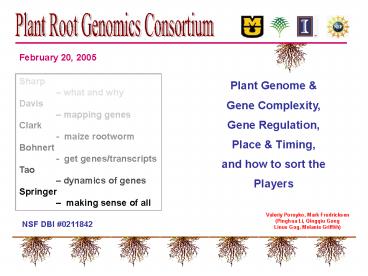February 20, 2005 PowerPoint PPT Presentation
1 / 25
Title: February 20, 2005
1
February 20, 2005
Sharp what and why Davis mapping
genes Clark - maize rootworm Bohnert -
get genes/transcripts Tao dynamics of
genes Springer making sense of all
Plant Genome Gene Complexity, Gene
Regulation, Place Timing, and how to sort
the Players
Valeriy Poroyko, Mark Fredricksen (Pinghua Li,
Qingqiu Gong Linus Gog, Melanie Griffith)
NSF DBI 0211842
2
The Plant Genome
Diploid Polyploid
Chrysanthemum species illustrate the phenomenon.
Monoploid number (the basic set) 9
chromosomes In Chrysanthemum species, the number
of chromosomes fall into 5 categories 18
chromosomes diploid (2 copies of the
monoploid) 36 chromosomes tetrapoid (4 copies
of the monoploid) 54 chromosomes hexapoid (6
copies of the monoploid) 72 chromosomes
octaploid (8 copies of the monploid) 90
chromosomes decaploid (10 copies of the
monoploid)
50 of all flowering plants are polyploid.
See Arabidopsis
3
AQP are distributed over all Chromosomes - a few
clusters, many duplications
Figure 3
4
Arabidopsis model plant small, fast,
prolific, mutants, lines, ecotypes, genome
sequence
Field on a dish!
5
(No Transcript)
6
Arabidopsis growing in the field in high CO2
and/or ozone
FACE-rings
down there
concept plant performance in the future earth
atmosphere (2040) - also soy, corn, weeds
7
The Plant Genome
Plants in silico? Sure! And then Plant
Design from Scratch
8
Controls for Gene Expression many
Switchboards
The Plant Genome
- Chromatin condensation state
- Local chromatin environment
- Transcription initiation
- Transcript elongation
- mRNA splicing
- mRNA export
- mRNA place in the cell
- RNA half-life
- Killer microRNAs
- Ribosome loading
Levels of regulation that affect what we
call gene expression
9
binding site for Pol-II sometimes recognizable
promoter
REs
ABRE DREB ERE response elements for every
condition number spacing
3 variable, condition-dependent
5
splicing alternative splicing
Watch out not only activators may bind, but
repressors as well! - think about you may need
an activator to make a protein that removes a
repressor.
10
The Plant Transcriptome
5 years ago, we did not know that such a
control system existed!
Killer RNAs (there are micro-genes)
microRNAs
11
The Plant Transcriptome
How to sample the transcriptome?
Morphological dissection remember Bob
Sharps talk! (root, leaf, flower -
epidermis, guard cell, etc.) Cell sorting
make single cells, send through cell sorter
(size, color, reporter gene) Laser ablation
micromanipulation of laser to cut
individual cells Biochemical dissection
chloroplasts, mitochondria, ribosomes,
other membranes
Painting cells with a reporter gene - here this
is GFP Green Fluorescence Protein
12
The Plant Transcriptome
Painting tissues then isolating desired cells
Enzymatic staining
The Endodermis of the root tip is highlighted in
transgenic plants using pSCRmGFP5.
13
Cell-Specific GFP Expression
- Catalog of available transgenic Arabidopsis
lines. - Lines are available from the stock centers.
- However, the molecular basis for the observed
phenotype is usually uncharacterized.
14
The Plant Transcriptome
cDNA complementary DNA converts messenger RNA
into double-stranded DNA
- gt cDNA libraries
- neat
- normalized
- subtracted
- gt SAGE libraries
Normalization removes mRNAs for which there
are many copies in a cell thus enriching for
rare mRNAs (not so much sequencing to do)
Subtraction removes cDNAs which you already know
(less sequencing)
15
cDNA Libraries
The Plant Transcriptome
Cloning of root RNAs from segments S1 S4 root
tip (Sharp lab) sequenced 18,000
clones found 8,000 unique and 130 novel
genes How many genes make a root?
16
The Plant Transcriptome
SAGE Serial Analysis of Gene Expression an
Overview
Isolate small regions (SAGE tags) of each mRNA
transcript in a cell
Isolate total RNA from cells or tissue
Digest tags and ligate into concatamers for
sequencing
Reference sequencing results against public
databases
17
FR697, 48 h after transplanting (from cell length
profiles)
WW00 WS05 WS48
WW
4 segments each barcoded then normalized sequence
6,000 from 17,000 seqs 8,000 different
mRNAs 800 never found before in any organism
WS
18
SAGE tags and EST contigs recognized in three
corn root libraries.
Problem - how to understand what the
meaning of 8,000 genes might be!
Figure 7
19
Translation ribosomes
Chromatin-associated functions
Cell cycle control maintenance
20
Nucleotide transport metabolism
Secondary metabolite dynamics
Ion transport
21
Importing data into Pathways biochemical,
developmental, regulatory
MapMan
22
The Plant Transcriptome
Quantitative PCR in 384-well plates (96 primer
pairs, 3 repeats each)
Taking SAGE cDNA sequences together - corn
roots express 20-23,000 genes (i.e., mRNA is
made) - The entire corn genome is expected to
include 50,000 genes
23
Why are we doing this?
- Genes expressed in well-watered conditions,
- how many, where and which?
- Changes during drought episodes?
- Variation in different lines or land races?
- Breeders to cross and select for tolerance!
- Proteins and substances (metabolites) made?
- (how to make a cell wall, how to defend against
rootworms) - Make corn with thicker (modified) cell walls!
24
Transcript Dynamics Wenjing Tao is next
mRNA 2
mRNA 1
DNA
Reverse Transcription labelling using Cy5 and Cy3
dyes
Array onto glass slides using Robotic Gridder
Block reactive groups Fix denature DNA
cDNA 2-cy5
cDNA 1-cy3
Measuring the ratio of expression (control to
test Population)
Hybridize
25
Thimm O, Blasing O, Gibon Y, Nagel A, Meyer S,
Kruger P, Selbig J, Muller LA, Rhee SY, Stitt M.
(2004) MAPMAN a user-driven tool to display
genomics data sets onto diagrams of metabolic
pathways and other biological processes. Plant
J. 37(6)914-39.
http//gabi.rzpd.de/projects/MapMan/
The program can be downloaded from this site. As
soon as I can, I will put together some real
data (published data) that you could insert into
the program and then manipulate.

